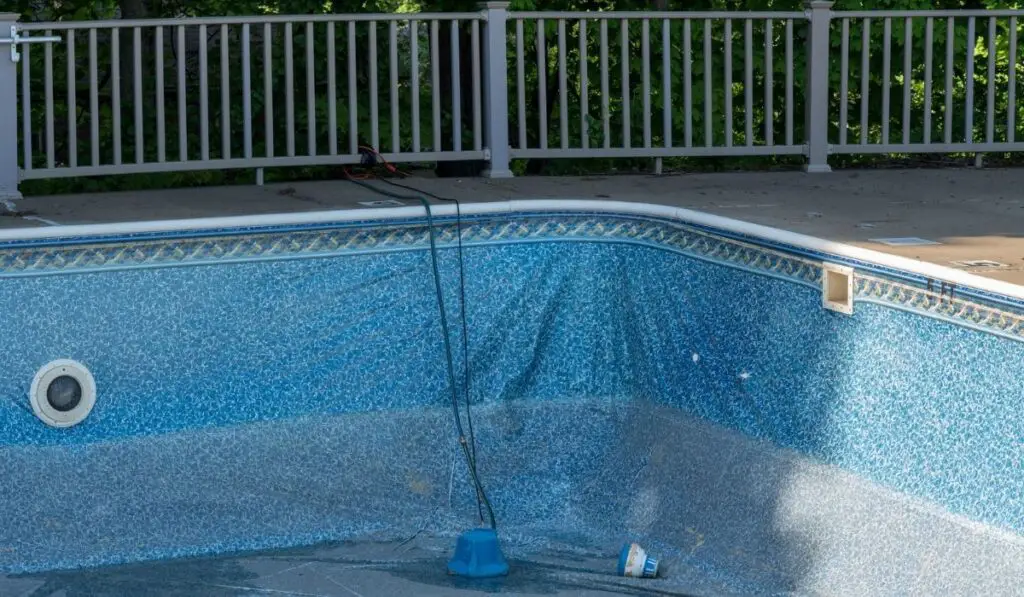If your pool has a liner, you may be wondering how long it will last. You’re not alone — it’s a fairly common question from pool owners. While some parts of your pool can last for decades, others unfortunately won’t.
A pool liner should last around six to ten years, depending on the type of pool you have (above-ground or inground) and how well it’s maintained. To get the most from your liner, monitor the water levels, keep the chemicals balanced, cover your pool seasonally, and keep an eye out for any punctures.
So, when it comes to your pool liner, what do you need to know? What factors play into longevity, and what does an old pool liner look like? More importantly, what can you do to get the most out of your existing liner? Let’s take a look at these essential questions.
How Long Does a Vinyl Pool Liner Last?

Your pool’s liner plays a critical function in protecting your pool. Not only does it give your backyard oasis a nice look, but it also keeps water from entering the actual structure of your pool.
In most cases, your liner is the only waterproofing your pool has. If there’s an issue with the liner, it can lead to other more serious problems that will require professional assistance
Most vinyl pool liners last somewhere between six and ten years. Of course, this depends on the type of pool you have.
Proper pool maintenance plays an important role here. The better you care for your pool, the longer your liner will last.
How Long Does an Inground Pool Liner Last?
As you might expect, inground pool liners should last a bit longer than the above-ground versions. This is because inground pools are a bit more protected from the elements.
Your inground pool liner should last anywhere from 6 to 12 years.
How Long Does an Above Ground Pool Liner Last?
Above-ground pools are perfect for homeowners who don’t want to commit to a large installation in their backyard. Moreover, above-ground pools tend to be cheaper when it comes to upfront installation costs. But, when it comes to liner longevity, what can you expect?
Above-ground pool liners will last 5 to 10 years.
What Is Covered in Your Pool Liner Warranty?
While your liner may come with a generous 25-year warranty, you should be aware of what you’re really getting. In most cases, when it comes time to make a claim, you’re in a stage of the warranty where you don’t get the kind of payoff you might be expecting. Let’s explore this more.
Pool liner warranties are extremely prorated. This means that with every passing year, they lose value. In most cases, you have around two to five years for a full warranty. After that, expect only a portion of the original payout.
When considering the lifespan of the average liner is around eight years, the prorated warranty usually results in a small payout, sometimes only 10% of the original price.
Moreover, liner manufacturers won’t cover the costs of draining your pool and labor, which will add up. At the end of the day, expect to get a little bit of assistance from the warranty, but the majority of the price of the repair will fall on you, the homeowner.
What Can You Do to Prolong the Life of Your Pool Liner?
If you’re looking at your pool liner and wondering how you can get the most out of your purchase, what do you need to know? Below, you’ll find some easy preventative tips.
Balance the Water Chemistry
Water chemistry is a huge part of pool maintenance. Not only is it the only way to prevent bacteria and mold growth in your pool, but it also plays a role in keeping your liner and other equipment operational. Always check and balance your pool’s chemicals.
Keep a regular balance schedule, or have a professional come take care of your pool. And make sure you have at least a simple pool chemistry kit like the Poolmaster 22260 Essential Collection Chemistry Set (on Amazon) on hand, so you never have to do any guesswork when it comes to your chemical levels.
Avoid Punctures
Punctures lead to leaks, and leaks lead to damage to your pool’s structure and your pool’s liner. If you suspect a puncture, crack, or leak, you should try and remedy the situation immediately.
This usually means trying to patch the puncture with a proper pool liner patching kit (on Amazon). Don’t just use duct tape or something similar, as it won’t last, and you’ll still be dealing with the leak in the near future.
Monitor the Water Level
The water level is another factor contributing to your pool liner’s health. Since the weight of the water is what’s keeping the liner in place, any imbalance can lead to damage.
This isn’t just if there’s too little water; problems can also arise from too much water. Too much water is a common problem in wet environments where heavy rainfall occurs frequently.
Cover Your Pool
Covering your pool is a great way to protect your liner. Not only can it help keep your water and chemical levels in proper balance, but it can keep debris from coming in and causing punctures. It’s also a great way to keep your pool protected during the winter.
How Can You Tell When It’s Time to Replace Your Pool Liner?

Now that you know liners won’t last forever, how do you know when it’s time to replace them? Here are some key signs:
- Cracks and rips in the liner
- Constant water loss from leaks and other liner damage
- Visible fading or stains
- Age (If your liner is over ten years old, it might be time for a replacement.)
